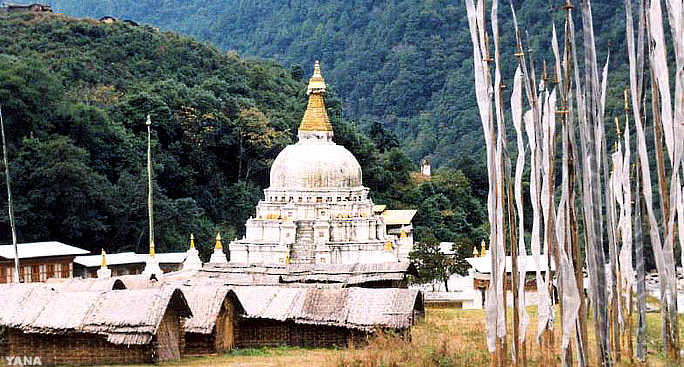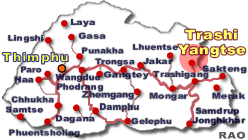|
Goenpas,
Monasteries & Lhakhangs
|
 |
Bhutan's
Festivals |
|
 |
Bhutan Information |
|
|
 |
|
Trashiyantse:
Chorten Kora Festival - Namgang Kora
|
 |
 |
| Devotees
from Tawang in the Indian state of Arunachal Pradesh joined their Bhutanese
counterparts in the Namgang Kora, one of eastern Bhutan's oldest religious
festivals which is held annually at the Chorten Kora, Trashiyangtse.
The
biggest religious event in the dzongkhag, the Namgang Kora (circumambulating
the Chorten on the last day of the auspicious first month) was preceded
by the Tse-Chenga Kora, a similar celebration on the 15th day of
the first month of the Bhutanese calendar. |
|
Lam
Dorji of Rigsum Goenpa who organizes the festival said that the tradition
of circumambulation began after the present chorten was built by Lam
Ngawang Lotey, the nephew of Zhabdrung Ngawang Namgyel. The
physical structure of the chorten was copied from the Bodi Chorten in Nepal.
Once
a deeply spiritual tradition, the event today has been commercialised and
diluted, according to devotees. With hundreds of shops set up in huts and
tents, Chorten Kora appears more like a bustling fair than a spiritual
venue.
This
year one of the main attractions at the festival has been the video parlours.
About five video parlours run by diesel generators screen three to four
of films a day. Food and game stalls, cloth show rooms, diverse wares both
made locally and imported line the way to the Chorten.
Gyeltshen,
79, from Bumthang visited Chorten Kora after 12 years. He is astonished
at the transformation.
"Those
days we walked all the way via Kurtoe to attend the great kora," he said.
"Today people are more attracted by business opportunities and entertainment."
Ngawang
a Trashiyangtse shopkeeper, makes a profit of about Nu 15,000 a day. That
is a far bigger earning compared with his usual business.
top
| The
festival of Chorten Kora 2007 |
 |
There
were fewer devotees both local as well as the visitors from Tawang in Arunachal
Pradesh, India attending the festival of Chorten Kora, popularly known
as Namgang Kora, this year.
Not
many are attending the Chorten Kora festival.
"It
could be because of distribution of devotees in and around the valley,"
said the principal of the institute for Zorig Chusum, Lam Kezang. "Most
of the local devotees are attending the biggest and longest religious ceremony,
Rinchen Terzoed Wanglung, which is being conducted by Lam Namkhai Nyingpo
at Tshenkharla Zangdopelri lhakhang and some devotees had gone to Gomphu
Kora to recite Badza Guru dungdrup which began on March 19."
The Namgang
Kora festival at Chorten Kora concluded on March 19, 2007. Unlike other
religious festivals, which have mask dance performances Chorten Kora is
a festival to circumambulate the chorten.
Like
Gomphu Kora festival, the Chorten Kora tshechu is also popular for its
culture of nightlife which has evolved around the festival. But, according
to the local people the tradition had deteriorated with the passage of
time and the spiritual significance of the festival had been diluted by
commercialism and rowdy youth.
The Namgang
Kora festival (the 30th day of the auspicious first Bhutanese month) was preceded by the Tshe-Chenga Kora or the Dakpai Kora, a similar
celebration on the 15th day of the first month of the Bhutanese calender.
The
festival or the tradition of circumambulation began after the present stupa
was built by Lam Ngawang Loday, nephew of the 13th Je Khenpo, His
Holiness Yonten Thaye (1771-1775). Lama Ngawang wished to construct
a replica of the Bodnath stupa of Nepal in Kholongchhu valley in memory
of his late uncle Lam Jangchub Gyaltshen, the founder of Rigsum Goenpa
monastery, and to subdue a demon dwelling at the site where the chorten
was to be constructed.
The
construction of Chorten took 12 years and was supported by the disciples
of Lam Ngawang Loday and devotees from Trashiyangtse, Trashigang and Kurtoe
valley, and also by people from the neighboring tribal communities of Tawang.
His Holiness Yonten Thaye made his second visit to the valley and consecrated
the chorten by offering mandala of Dechhog Paochigpa.
Another
legend says that while the construction of chorten reached its dome, a
girl of eight-years old believed to be an angel from Tawang came and volunteered
to enter the dome and be buried. On account of this incident, the 15th
day of the first Bhutanese month is called the Dakpe Kora (circumambulation
by the Dakpas from Tawang) and the 30th day is called the Namgang Kora
or the Drukpe Kora (circumambulation by the Bhutanese) festivals are held
every year and hundreds of devotees from far and near converge at the Chorten
Kora..
| Contributed
by Rinzin Wangchuk, KUENSEL, Bhutan's national newspaper, 2007 |
 |
| Information on Bhutan |
 |
 |
|
Chorten
Kora - Namgang Kora
|
|





